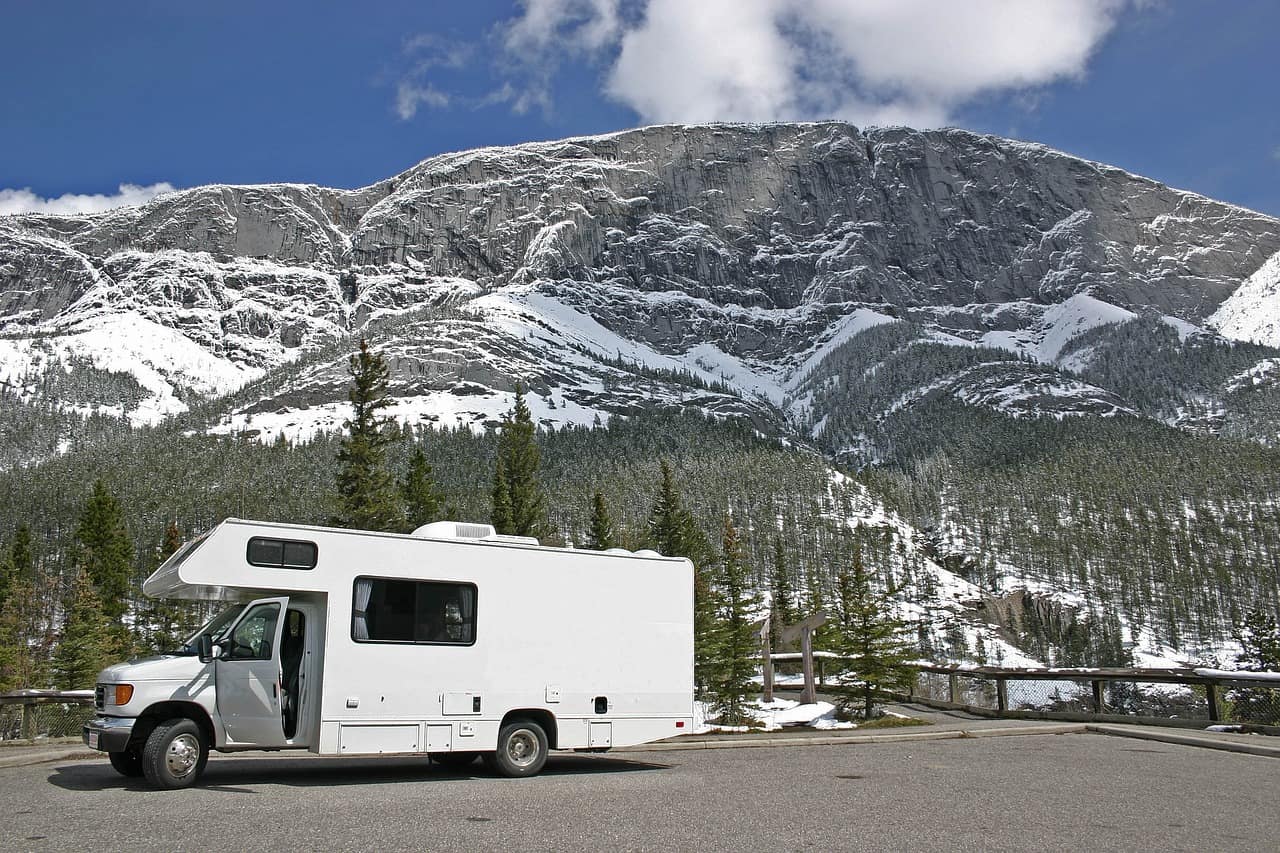RV living is often an adventure: Exploring new places, meeting new people, and finding community among other RVers.
And in the warm months, RVing is comfortable and enjoyable…
But when the winter starts to set in, life in a metal home on wheels can get tough. In order to maintain comfort and safety in the cold, RVers need to prepare by winterizing our vehicles.
Here, I’ll take you though the reasons why winterizing your RV is necessary in frigid temperatures, how to do it, and what you’ll need to maintain a well-running, livable RV in the cold.
When Should You Winterize Your Motorhome?
The severity of winter depends on your location and time of year. For some northern areas, the winter season starts as early as September.
Heading further south, however, the impact of the winters varies greatly and can actually be a bit of a gamble.
That’s why it’s always more convenient to winterize your home according to temperatures rather than specific times of the year, especially if you travel around in your motorhome often.
Ideally, the actual winter effects start to show on your vehicle when temperatures start to hit 32 degrees Fahrenheit or lower.
For that reason, a good rule of thumb here is to consider winterizing your camper as the temperature starts to drop towards this critical mark.
Why Winterize a Motorhome?

Early Preparation Means Lower Repair Costs
Even if you’re not ready to live in your RV during winters, the cold will have its way with your vehicle. When the cold season passes, your RV will require some sort of maintenance and repairs.
However, by carefully winterizing and insulating your motorhome through winter, you should expect to pay much less on repair costs.
Avoid Freezing Water Lines and Car Parts
If you don’t protect the plumbing water system in your motorhome, all the liquids will start to freeze and expand, causing the fitting and line tubes to break.
Proper winterizing will help you avoid this, as well as help you dodge the expenses of changing all these fittings for the next season.
Prevent the Formation of Mold
If moisture from winter accumulates inside your motorhome, parts of the vehicle will start to rot with mold, moss, and fungi.
This can damage various parts of your interior, including wooden and metallic items as well as the wire.

Control Pests and Insects During Winter
You might think that it’s less likely for insects and rodents to be out in the winter, and you’d be correct. However, it’s much more rewarding for them to find a water shelter with plenty of food.
By properly sealing the RV against the cold, you’ll also prevent these tiny critters from reaching into your motorhome.
What Are the Essential Supplies for Preparing Your Motorhome for Winter?
Here are some of the essential supplies that you’ll need to insulate your Motorhome and protect it against winter.
RV Skirts
One of the best supplies that can keep your motorhome warm in winter is an RV skirt. Adding a skirt around your motorhome will keep the under carriage warmer for a longer period of time.
Not only will this add to the overall warmth and decrease heat loss from the inside, but it’ll also help you save money on heating.
You can make an RV skirt from a variety of materials, such as plywood and vinyl. Many different insulating materials will do the trick, but avoid fire and moisture-prone materials like hay bales and straw.
Antifreeze
Antifreeze is a liquid additive that helps in lowering the freezing point of all water-based liquids. This magical fluid will help you maintain your water system inside the RV and protect it from freezing and ruining the engine as well as your pipe system.
Ideally, 2 to 3 gallons of pink RV antifreeze will get the job done. (don’t use the toxic green one that goes into cars).
The amount needed depends on the length and layout of your plumbing lines. However, it’s never a bad idea to keep some spare antifreeze for unforeseen situations that may arise.
Sealing Vents
Vents, windows, and doors are the ideal spots for the heat to leak out. While skirts will take care of the underside of the camper, you can also apply thermal curtains to keep things warm.
Proper Pipe Care
Taking care of the water system inside your RV is the gold standard of winterizing.
In addition to antifreeze, you’ll also need some items like a heated RV water hose for drinking. However, you can always drain your water system entirely and use bottled water or jugs for potable drinking water.
How to Winterize Your Motorhome: Step by Step Guide
Keep in mind that it’s not recommended to fully winterize your RV if you’re going to live in it. Full winterizing means that you’ll fully drain all the water and plumbing systems in the vehicle.
Now that you know the essential and the valuable gadgets that can help you overcome winters in your motorhome, let’s head to a step by step guide to preparing your RV for living in winter.
1. Protect the Piping System from Freezing
For the water system, you have three options, which are:
● Completely drain your plumbing system of water and use bottled water for drinking
● Insulate your pipes from the cold by using heat tape while using heated water hoses
● Pour some nontoxic antifreeze in the gray and black tanks
2. Establish a Reliable Heating Mechanism
Propane furnaces for campers will be your bread and butter while living in your motorhome in winter.
They’re extremely efficient at keeping the weather inside warm and toasty. However, propane will run out faster than you might think.
That’s why it’s always essential to have plenty of propane reserve around you and throw in an additional electric heater for campers (like this Honeywell space heater that we use in our own RV) for good measure. This way, you’ll be able to get by the night cold and get extra propane tanks in the morning.
3. Install or Upgrade the Motorhome Insulation
For heat insulation, make sure you apply the RV skirts below the motorhome as well as sealing doors, vents, and windows.
Additionally, throw in some heavy drapes or window coverings to keep the heat in.
4. Ensure the Health of the Motor
If you’re going to move around a lot, a good rule of thumb is to check the health of both your engine and batteries first.
Make sure that there are no signs of damage or corrosion on all the vehicle’s mechanical aspects. Moreover, you can get a reliable generator to power up your motorhome in case of an emergency.
5. Moisture Proof the Interior with Chemical Adsorbents
To avoid the accumulation of moisture inside your motorhome, you’ll also need to throw in some adsorbents to keep the air dry.
Moisture controllers work best for this purpose. Silica beads can also be effective, but beware of keeping any toxic beads around children, pets, or your food.
How Long Does it Take to Winterize and De-winterize Your Motorhome?

The actual duration of the winterizing process depends mainly on many factors. For example, if you’re doing extensive winterization for super cold areas, it might take you up to 3 to 4 hours, especially for someone who hasn’t done that before.
However, most regular winterizing might take you anywhere between 1 or 2 hours for both the winterizing and de-winterizing of your motorhome.
How Much Does it Cost to Have Your Motorhome Winterized?
Although winterizing is fairly simple and doesn’t require costly supplies to get done, some people might consider hiring someone to get their motorhome winterized.
Most reputable motorhome service centers can get the water system in your RV winterized. This can cost you anywhere from $80 to $100. However, if you have additional appliances that utilize water, the costs can easily double.
It’s always wiser to do the winterizing project yourself, as they mainly focus on your RV water system. Also, it would cost you a fraction of that price to get it done yourself.
Wrap Up
There you have it. A complete guide about living in a motorhome in the winter. As you can see, winterizing your RV is critical whether you’ll live in your RV camper or not.
Luckily, the process of preparing your motorhome for winter isn’t as difficult as you might think, and doing it yourself will save you a lot of money since it’s quite easy to pull off.

